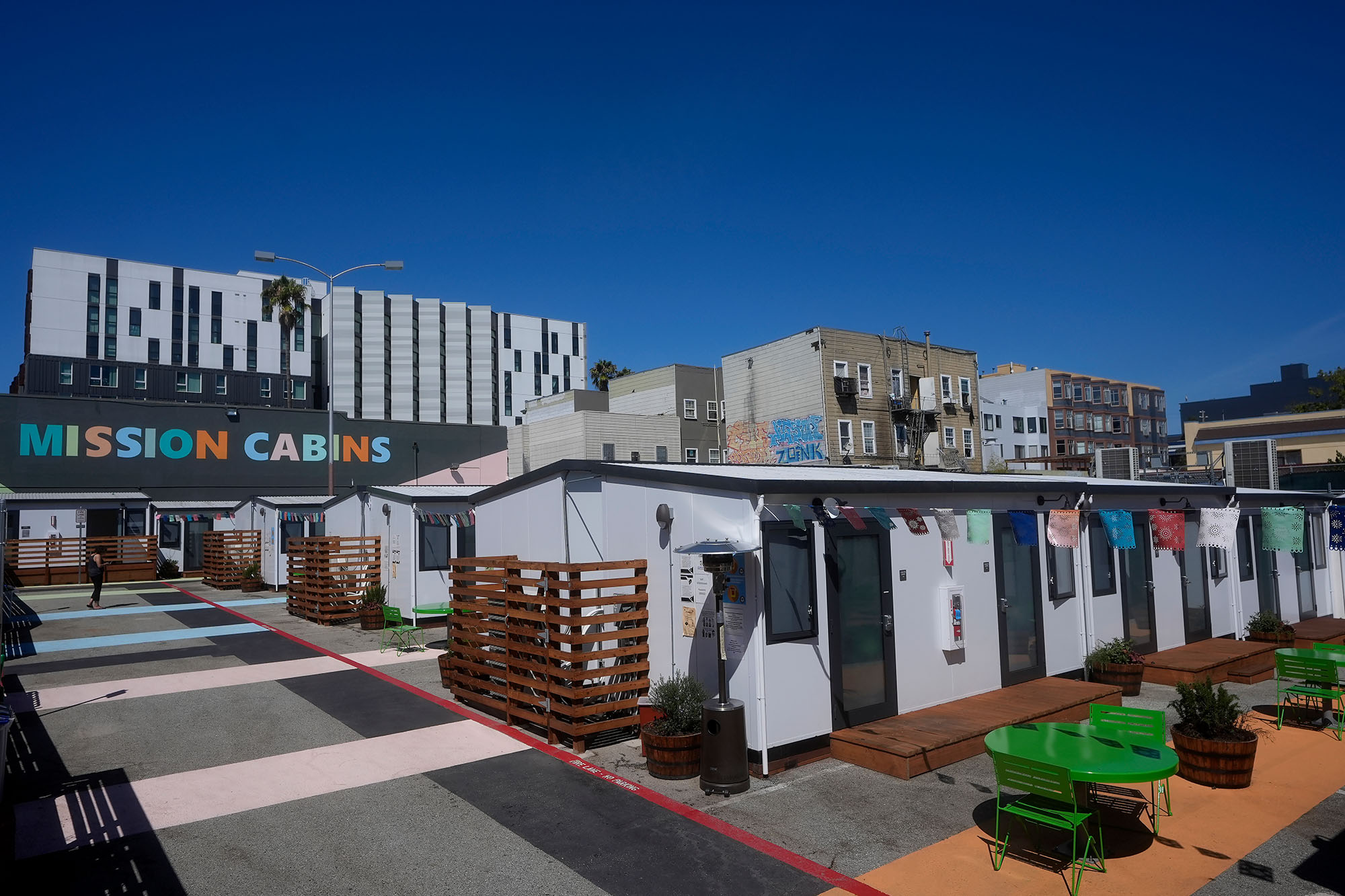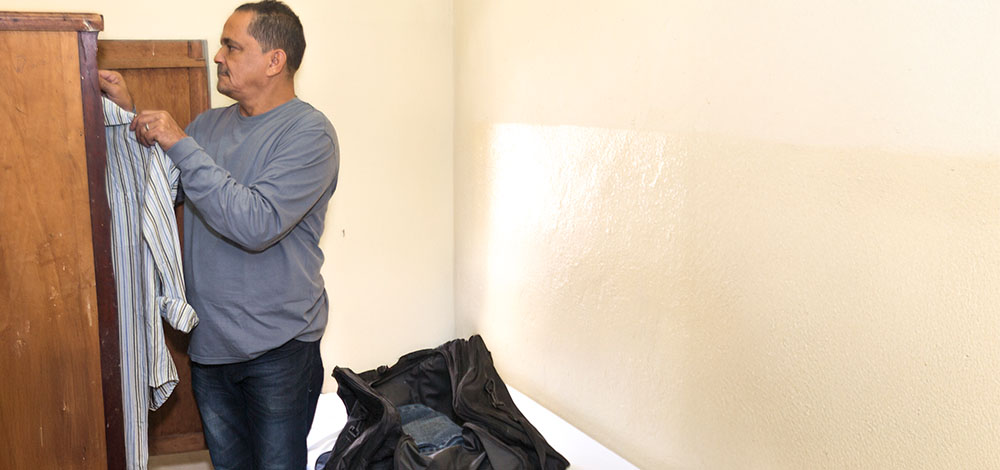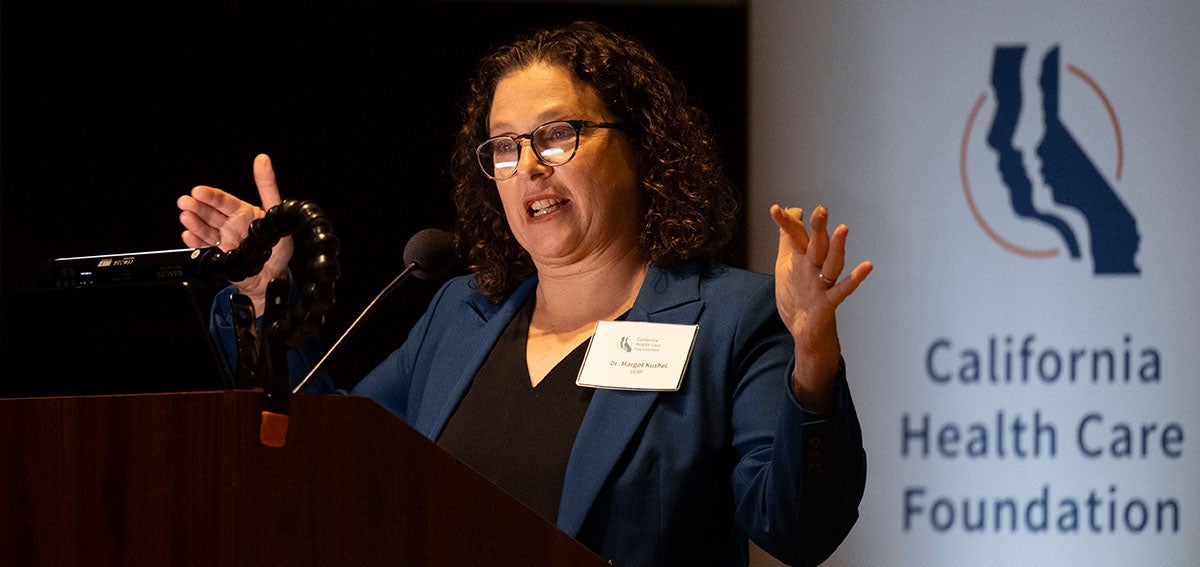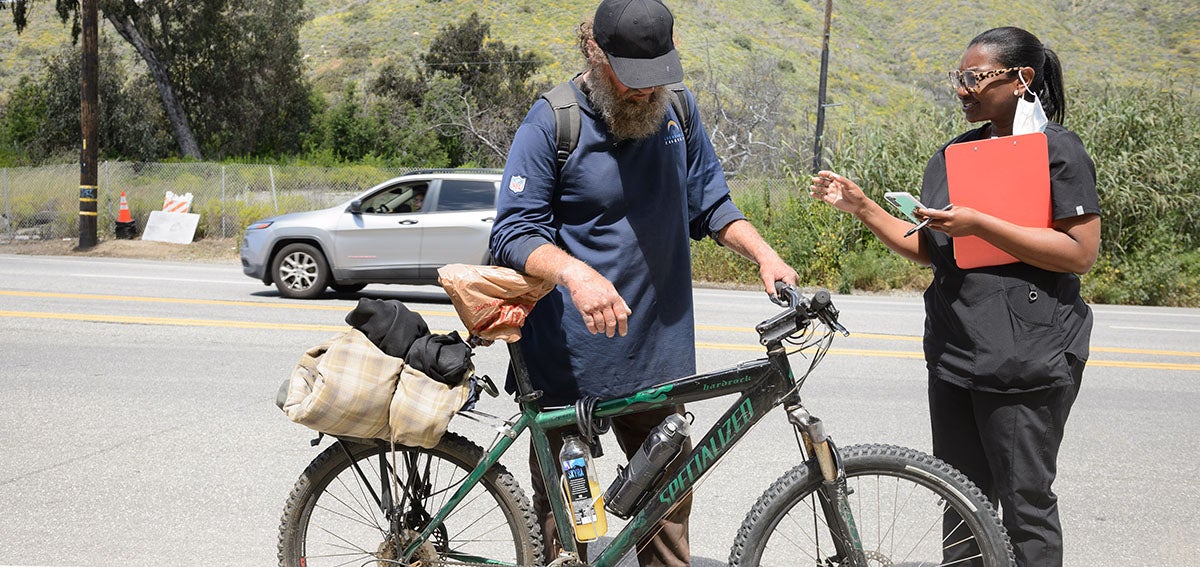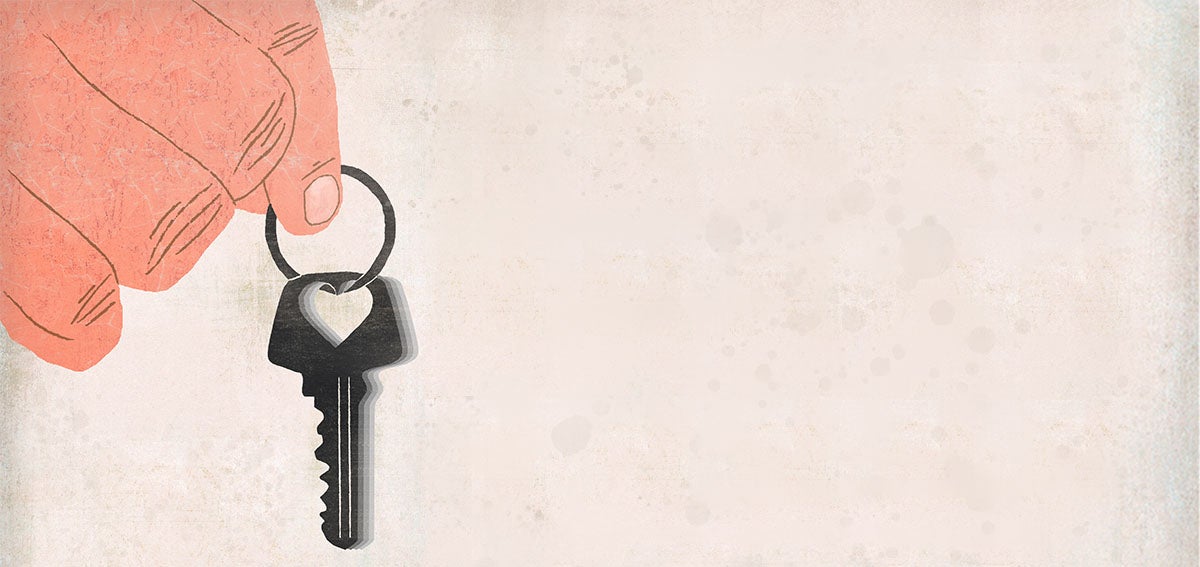
For three years, Enrique Castro, 58, lived on the streets of Los Angeles, trapped in a personal horror movie. He heard threatening voices, disturbing sounds that convinced him someone was monitoring him, and he felt he was being punched by invisible attackers. “It was very confusing and scary,” he said. The hallucinations “put me in a bad place. They gave me a lot of trauma.”
Castro was living with psychosis, which causes sufferers to lose connection with reality. He was chronically undernourished and dehydrated because he lacked regular access to food or water, and experiencing homelessness meant he had no place to shower or attend to basic hygiene needs. These circumstances put Castro at high risk for getting seriously sick with COVID-19 when the pandemic arrived in early 2020.
About one-quarter of people experiencing homelessness in the Los Angeles area are 55 or older, and almost 40% of all people experiencing homelessness are struggling with a self-reported physical disability, a serious mental illness, or substance use disorder. These health problems are exacerbated by substandard living conditions, inadequate nutrition, and lack of access to health insurance. The pandemic heightened the risks for people like Castro, because older people and those with chronic health conditions are more likely to develop complications from COVID-19. Delivering health care to this vulnerable population had never been more essential, yet it highlighted the struggles that health care providers had long faced when trying to reach and care for people experiencing homelessness.
Recognizing the risks COVID-19 posed to the unhoused, California in March 2020 launched Project Roomkey to provide temporary shelter in hotels and motels to tens of thousands of Californians. Research shows that, once housed, the physical and mental health of people experiencing homelessness often vastly improves, which in turn makes them better able to ward off disease. Castro was one of the people who entered Project Roomkey. He spent six months at a converted motel in Lawndale before moving into permanent housing.
“It’s not that their health conditions are necessarily different, they’re just complicated by the conditions that people live in.“
—Al Ballesteros, JWCH Institute
This unprecedented rapid action to move people into shelters gave health care providers a unique opportunity. Under a $2.3 million grant program called Health Pathways Expansion (HPE), developed by the United Way of Greater Los Angeles, 16 local health care organizations and clinics tested an unusual strategy. Instead of waiting for people to come to a clinic or searching the streets for them, the health care providers brought the medical services directly to people staying at Project Roomkey hotels.
In less than a year, HPE grantees treated more than 3,500 clients and provided more than 14,000 consultations for medical, behavioral, and substance use services. An evaluation of the program (PDF) concluded that the approach successfully allowed providers to treat some of the area’s hardest-to-reach people, showing promise as a longer-term strategy. The project highlighted the complexities of providing meaningful, consistent health care to people without a stable address, and it revealed an urgent need for greater public and philanthropic investment in making it easier for people experiencing homelessness to obtain health care.
The Hazards of Being Unhoused
Homelessness is a health hazard. People who are unhoused suffer higher rates of illness and can expect to live 12 years less (PDF) than the general population, according to mortality data. While health problems can lead people to lose their homes, the experience of homelessness often causes or exacerbates bad health. People without a home are exposed to extreme stress, violence, inclement weather, communicable diseases, and malnutrition. When they get sick or injured, they have nowhere to heal and rest. With no reliable access to refrigeration or safe storage space, most are not able to store medications or maintain a medically tailored diet. Infections and chronic health issues worsen. Behavioral health problems such as depression or substance use disorder can develop or escalate because of trauma and feelings of hopelessness.
“The issues that homeless people deal with in terms of their health are the same as anybody else,” said Al Ballesteros, CEO of the nonprofit health agency JWCH Institute. “They’re dealing with HIV, which requires that they take medications on a regular basis, that they get their labs checked. They’re dealing with hypertension and diabetes. It’s not that their health conditions are necessarily different, they’re just complicated by the conditions that people live in.”
Most of the HPE grantees were working with people experiencing homelessness before the pandemic and were familiar with these challenges. Some, like the Keck School of Medicine of USC, Venice Family Clinic, and Los Angeles Christian Health Centers, had street medicine teams. A few, such as East Valley Community Health Center, had sent clinicians to homeless shelters. Others, such as Central Neighborhood Health Foundation, offered care solely inside brick-and-mortar clinics. None had offered care to people in homeless shelters at the scale facilitated by the HPE grant.
Bringing medical services directly to shelters allowed grantees to reach people who were too sick, demoralized, or scared to make it to a clinic. And because medical teams returned regularly to the Project Roomkey hotels to see residents who stayed on for weeks or months, many were able to build rapport with patients who initially were skittish about seeing a provider.
Life-Changing On-Site Care
“A lot of our clients are afraid to go see doctors or go to hospitals,” said Judit Ochoa, who served as interim program manager for a Project Roomkey hotel run by Union Station Homeless Services. “Having those medical service providers come on-site is life-changing for this population.”
Visiting clients where they reside also can give medical workers clues about the person’s health that would not be apparent in a clinic setting, said Brett Feldman, director of the street medicine team from the Keck School of Medicine of USC in Los Angeles. Expired food in the trashcan, for example, could explain why someone has diarrhea. In one instance, the chaotic room of a normally tidy client alerted medical workers that the person had a psychiatric illness.
In some cases, homeless services staff benefited from the on-site medical presence too. Behavioral health provider Homeless Health Care Los Angeles trained Project Roomkey staff on how to respond to drug overdoses and provided supplies such as fentanyl test strips and Narcan nasal spray, a treatment to reverse opioid overdose. Having medical workers on location also eased pressure on staff who no longer had to spend hours calling in paramedics and waiting for them to arrive, said Mayra Chaidez, the divisional homeless services director for the Salvation Army. Paramedics are usually the go-to option for tending to clients who are ill, she said. Although staff encourage them to go to their medical doctor, many don’t follow through because they lack transportation, she said.
Not everything went smoothly. Both Project Roomkey and the HPE program were implemented quickly in response to the pandemic, and that urgency led to some miscommunication and coordination challenges. COVID-19 outbreaks sometimes disrupted grantees’ ability to offer care. Grantees also noted that it’s not possible to transport all the medical equipment and services available at clinics to a pop-up outside a hotel. Many clients still needed referrals for specialty tests, dental work, psychiatric services, or other follow-up care.
“There’s only so much you can do with the mobile team,” said Ballesteros. “You’re always doing better for the client when you’re connecting them to a medical home, as well as housing.”
Grantees succeeded in establishing primary care medical homes for nearly 3,000 clients. However, many clients in Project Roomkey came from other areas and later moved again, which made it difficult to anchor them to a medical home, some grantees reported. And there’s little data on how many clients followed up on referrals or on their long-term health outcomes.
Viable, Worthwhile Strategy
Overall, the grantees, homeless services providers, and evaluators of the HPE program said serving patients in facilities next to hotels and shelters is a viable and worthwhile strategy. Expanding the scope of this work would require ongoing funding for coordination, as well as investments in portable equipment, grantees said. It’s important that funding for these projects be flexible, as it was with HPE, said Joelle Green, director at Harder+Company Community Research, which led the evaluation. That’s because, while Medi-Cal and other health insurance programs cover the actual provision of health care and some case management, reimbursement structures are too rigid to cover all the extra effort and coordination required before and after a health care visit takes place to ensure people experiencing homelessness obtain the complex care they need.
“Getting reimbursed for the care itself is not a problem,” Green said. “There are many different funding streams, and a very high percentage of the clients that were seen were already enrolled or were able to be enrolled into a health care plan. . . . It’s not the reimbursement for the care that’s the issue, but everything else.”
Kathy Proctor, clinic administrator at Northeast Valley Health Corporation, suggested establishing permanent clinics within or adjacent to shelters and supportive housing sites so clients can access immediate care more regularly. Moving clients as quickly as possible into permanent supportive housing that includes on-site medical, behavioral, substance use, and even dental services would be the most effective, Proctor said.
“Adjacent is better than a mobile clinic . . . unless you have mobile sites coming all week long,” she said. “That’s how you can really help keep people stable in their housing.”
Toward Stability
For Castro, getting into Project Roomkey was a step toward stability, providing him with a secure place to sleep and shower and access to on-site nurses as needed. He was placed at the site by St. Margaret’s Center in Inglewood, which partners with Venice Family Clinic to provide medical care to people experiencing homelessness. Through this partnership, he was connected to a nearby clinic where he received a diagnosis and medications for his mental health condition.
Today, Castro lives in permanent housing at a converted motel in Whittier, part of a Project Roomkey follow-on program called Project Homekey. His mental and physical health are much improved, he said, and he is no longer hearing voices or experiencing hallucinations.
With a place to live and his health stabilized, Castro can now focus on new goals to further improve his life. He plans to apply for a replacement permanent residency card (he lost his old one when he became homeless) and to find a job. He has applied for Section 8 rental housing assistance, and he hopes to use it to secure an apartment with more space than his current motel room.
“Everything is going pretty well right now,” he said. “I feel better.”
This article is dedicated to the memory of John Velasco, who graciously shared his story for an earlier draft of this piece and who unexpectedly passed away. Unlike the many people who tragically die alone on the street, Mr. Velasco died with dignity, in a place of his own, and with the support of a care team.
Authors & Contributors

Claudia Boyd-Barrett
Claudia Boyd-Barrett is a longtime journalist based in Southern California. She writes regularly about health and social inequities. Her stories have appeared in the Los Angeles Times, San Francisco Chronicle, San Diego Union-Tribune, and California Health Report, among others.
Boyd-Barrett is a two-time USC Annenberg Center for Health Journalism fellow and a former Inter American Press Association fellow.

